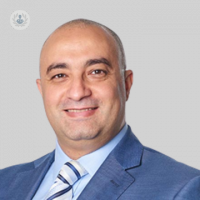Recovery and associated risks: What to expect following keyhole bunion surgery
Written in association with:When preparing for any type of surgery, it’s essential to be aware of the potential risks associated with your procedure and what to expect from the recovery period to follow. Fortunately, thanks to modern, minimally invasive techniques, risks of complications are rare and for patients, the road to recovery is smoother than ever. We invited highly respected consultant orthopaedic surgeon Mr Hisham Shalaby to share his expertise in this informative guide on recovery from minimally invasive bunion surgery and the potential risks to be aware of.

How long is the recovery period after keyhole bunion surgery? What can I expect during the healing process?
The operation is done as a day case and after surgery, the foot is wrapped in a bandage which stays on for the first two weeks. You can expect to be fully weight-bearing straight away. Patients are given a Velcro shoe to accommodate the bandage as well as crutches if needed. At the two week mark, they attend the treatment room to have the sutures removed and at six weeks, they come again for a follow-up appointment and X-rays.
In the postoperative period, it's quite important to have the leg elevated because that reduces swelling considerably and helps a lot with recovery. Patients can gradually build up their walking distances from there, and activities like non-impact sports, such as swimming and cycling, can be introduced at the six week postoperative mark.
In terms of returning to work, this will very much depend on the type of work you do. If the patient works from home, they can be back to work as soon as just a couple of days after surgery. If the job is generally sedentary, patients can usually go back to work after two weeks but for a more physical job, six to eight weeks can be required before the bones start to heal.
Even with minimally invasive surgery, healing of the bone still takes time. Much like with open surgery, the bone becomes sticky after six weeks and solid at around 12 weeks. During that period, swelling can still come and go, so this is something that patients also need to take in to consideration.
Are there any potential risk or complications associated with minimally invasive bunion surgery?
Just like any operation, keyhole bunion surgery has its own risks, the most common being swelling. Swelling can last for a long period of time, coming on and off for a good while before ultimately fading away.
There is also a risk of infection, which usually happens as a superficial infection that demands some treatment with antibiotics. Another potential risk is wound healing problems. Sometimes the use of the burs in surgery can generate some heat, which can cause some focal burn or injury to the skin. This is a technical problem that should be avoided as much as possible by the surgeon but it’s important to be aware that wound healing problems can happen. They might require dressings on and off for a while until the wound is healed.
In addition, issues like haematoma formations or blood collections can happen when the patient dangles their foot down for long periods in the very initial postoperative stage. For this reason, we always advise that patients keep their foot elevated. There is also a small nerve that runs on the top of the big toe which can be injured or irritated. Usually, this irritation is caused by swelling and so once this subsides, the nerve typically recovers.
We also consider the level of the correction made during the procedures, and under correction and over correction are possible problems, as well as recurrence of the deformity. Bunions or deviation of the big toe can recur in around 5 per cent of patients, particularly if patients choose to wear shoes that can squish the toes together, such as stilettos. As such, patients should avoid these styles of shoes as much as possible.
Very rarely, the cuts that we make in the bone can fail to heal. This tends to happen in patients who are heavy smokers. Aside from these, any other risks are just the generic risks of any surgical procedure. Overall, all types of risks are far reduced in patients who are fit and healthy and particularly those who are non-smokers.
If you require bunion surgery and wish to discuss the available treatment options, visit Mr Hisham Shalaby's Top Doctors profile to schedule a consultation.


